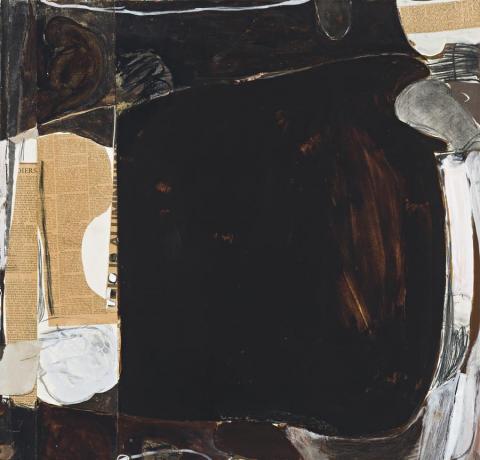UNTITLED BLACK COLLAGE, 1961
Brett Whiteley
oil, gouache, pencil, charcoal, newspaper, fabric, string and collage on paper on board
70.0 x 73.5 cm
signed and dated verso: UNTITLED BLACK COLLAGE / Brett Whiteley ‘61
G. Milman, Southport, England, purchased from Matthiesen Gallery, London
Whitford and Hughes, London
Edward and John Barkes, Sydney and London
Bridget McDonnell Gallery, Melbourne, 1995
Gould Galleries, Sydney, 2000
John Playfoot Fine Art, Melbourne, purchased from Gould Galleries, 2000
Melbourne Fine Art, Melbourne, 2006
Private collection, Melbourne
Brett Whiteley: Paintings and Gouaches, Matthiesen Gallery, London, 9 – 31 March 1962 (exhibited but not catalogued)
Modern Australian Paintings, Bridget McDonnell Gallery, Melbourne, July 1985, cat. 29 (illus.)
Modern Australian Paintings, Bridget McDonnell Gallery, Melbourne, 1 – 24 November 1995, cat. 26 (illus.)
Melbourne Fine Art, a mixed exhibition held in Sotheby's exhibition space, Sydney, 9 – 13 October 2002
Brett Whiteley, Gould Galleries, Sydney, 3 August – 3 September 2000, cat. 2
Cormack, R., 'Brett Whiteley: Matthiesen Gallery', The Arts Review, London, vol. XIV, no. 4, March 1962, p. 9 (as 'Black Collage')
Sutherland, K., Brett Whiteley: A Sensual Line 1957–67, Macmillan Art Publishing, Melbourne, 2010, pp. 250–251 (illus.)
Awarded the prestigious Italian Travelling Scholarship from the Art Gallery of New South Wales in 1959, Brett Whiteley thus departed upon his first pilgrimage overseas in early 1960. Based first in Rome, then in Florence, the young artist was immediately seduced by the flat, abstract qualities of the late Byzantine tradition which he perceived in the rich, glowing panels of early Renaissance masters Duccio, Cimabue and Piero della Francesca. Moving to London where he would remain for the next seven years, Whiteley continued to draw inspiration from these Italian memories, combining the ambience of Renaissance painting and sculpture with the earthy hues of Australia (as reflected in the palette of Russell Drysdale) and the semi-erotic abstractions of American artist Arshile Gorky, to create a series of highly sophisticated works such as Untitled Black Collage 1961 whose curvilinear forms powerfully integrate figuration and abstraction.
Discussing three such paintings which featured in the exhibition of recent Australian painting at Whitechapel Gallery, London in 1961, curator Bryan Robertson observes: 'The paintings were of startling maturity, richness and spiritual and imaginative poise, perfectly at ease in their medium and wholly original. It was hard to believe they were by such a young artist. The images weren't merely sophisticated or knowing, but totally realised in depth, filled with youthful panache and energy, and above all, a personal vision.'1 Not surprisingly perhaps, Whiteley's work created an enormous sensation - the Tate Gallery purchased Untitled Red Painting 1960 (making him the youngest contemporary artist represented in its collection) and suddenly, the artist's international reputation was launched.
No doubt encouraged by his newfound celebrity status and sales to major British institutions, accordingly in 1961, Whiteley embarked upon his first sustained body of work dedicated to exploring the physicality and sensuality of the painted surface and its potential to evoke emotion and mood. Thirty-one such abstractions (including the present) were subsequently exhibited in his inaugural solo show at Matthiesen Gallery, London in March 1962 - another outstanding commercial success despite the lukewarm critiques. A superb example of this preoccupation with texture and tactility, Untitled Black Collage encapsulates well the way in Whiteley heightened the dramatic physical presence of the canvas at this time, manipulating the relationship between flatness and relief by juxtaposing areas of non-colour (in this case, black, white and tonalities of grey) with various types of collage including fabric, string and newspaper. As such, Whiteley's technique here bears striking affinities with the single flag compositions executed by his American contemporary Jasper Johns from 1955-60, in which fragments of legible newspaper are featured alongside those obscured by an overpainting of gouache, thus demanding further scrutiny by the viewer - a device which would later be fully exploited by Whiteley in his provocative Christie series as a deliberate strategy to heighten viewer participation.2 More specifically perhaps, the use of collaged newspaper fragments in Whiteley's work at this time may be interpreted autobiographically as a bridge between the artist, his art and his aspirations; as Kathie Sutherland elucidates in her recent monograph, 'By making negative comment on commercial art Whiteley distances himself from a background in the advertising industry which, by now, he regarded as detrimental to his credibility as a 'serious' artist, an image that considerable anecdotal evidence suggests he was at pains to convey.'3
1. Robertson, B.,'The London Years' in Pearce, B., Brett Whiteley: Art and Life, Thames and Hudson with the Art Gallery of New South Wales, Sydney, 1995, p. 9
2. Sutherland, K., Brett Whiteley: A Sensual Line, Macmillan Art Publishing, Melbourne, 2010, p. 68
3. Ibid.
VERONICA ANGELATOS
